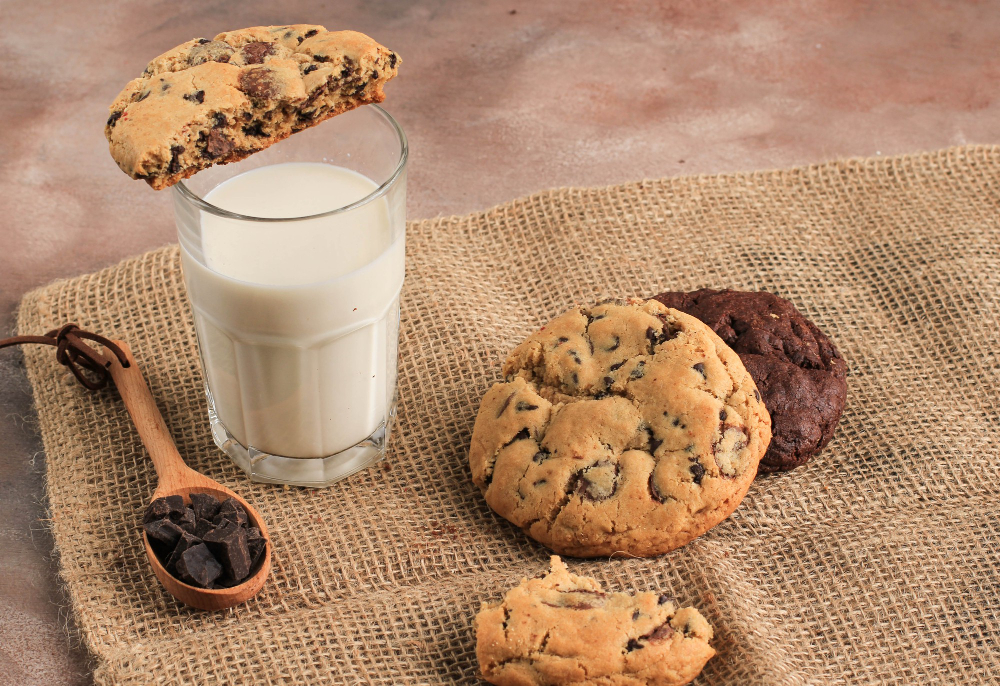Tate’s-Style Thin and Crispy Chocolate Chip Cookies Recipe
When it comes to dessert, thin and crispy chocolate chip cookies are the king. They are so delectably rich, crunchy and light that it is difficult to just stop at one or even half a dozen when you start taking them.
In contrast to the majority of store-bought cookies, the ingredients for Tate’s chocolate chip cookies are as simple as they come: chocolate chips, flour, butter, cane sugar, brown sugar, eggs, baking soda, salt, and vanilla.
Even if you don’t particularly like Tate’s, it’s difficult to disagree with such a short list of ingredients and the kind of mouthwatering chocolate chip cookie that any baker can make at home using the same components.
You might ask yourself what then is the difference between thin and crispy chocolate chip cookies and chewy and thick cookies since they both use similar ingredients. Well, everything boils down to technique and ratios. Chocolate chip cookies may be beautifully thin, golden, and buttery, with a brittle sort of crunch, if the proper ingredients are combined in the right way.
Limiting the Growth of Gluten for a Fine Crunch
All cookies get crunchy if they are baked for a long enough time, thus in general, crunch is one of the simplest features to imitate. Producing the proper crunch—one that is delicate and crisp (tender) rather than strong and hard—is the challenge (tough). To do this, we must restrict the dough’s ability to produce gluten. A cookie’s structure and the satisfying chew of softer varieties are both due to gluten. However, the chewiness and structure of a cookie may appear downright hard after it has dried out in the oven.
Selecting the proper all-purpose flour is the first step in reducing the formation of gluten. For cookies, this means choosing a somewhat starchy, low-protein variety; my favourite. Avoid all-purpose flours composed entirely of hard red wheat, which is so rich in protein that it may be used in place of bread flour.
It’s all about technique in the second part of preventing gluten formation. The flour and egg are the last ingredients to be put in a conventional chocolate chip cookie after the fat and sugar have been aerated using the creaming technique.

Because of the buttery coating, the sugar, which loves moisture, isn’t able to absorb all the water in the egg, leaving plenty for the wheat to hydrate and encouraging the creation of gluten, which gives the food structure and crunch. Aeration, which prevents the spread and maintains the cookies’ amazing thickness, is currently taking place.
Here, I use a technique known as the reverse creaming method to reverse that approach. By mixing the fat and flour from the beginning, the buttery coat develops a physical barrier between the proteins in the flour and the water, delaying hydration and reducing the quantity of gluten that can develop.
It’s a technique that is more usually employed in recipes that utilize a small quantity of sugar to create meals like biscuits, muffins, and scones pliable and light.
Chocolate Bars Maintain Their Shape
Once you’ve added the chocolate pieces, mix the mixture two or three times to incorporate. Normally, I love chocolate that has been chopped, but for this dish, commercial morsels work best. They not only capture the ideal copycat feel but also prevent the chocolate from fusing with the dough and retaining its distinct flavour and texture.
Mixing the Dough
This “mix” for cookies can be kept in the refrigerator for up to a week or used straight away. Transfer the mixture to a large bowl in either scenario, then stir in the egg and vanilla extract.
Use a flexible spatula to stir until the wet ingredients are gone. The mixture will appear absurdly dry at this point, leading you to believe something has gone wrong. However, as soon as you begin hand-kneading, the dry mixture will immediately blend into a wet and sticky dough.
Baking and portioning
Using a half-sheet pan coated with paper, divide out the dough into roughly one-tablespoon parts, making sure that each scoop is level and flat.
To allow for dispersion, space each biscuit far enough apart. These cookies will increase in size despite their one-tablespoon size appearing to be modest. This recipe yields a large number of cookies—56, to be exact—because the widespread enables large cookies to be formed from tiny parts.
Bake the dough for 16 minutes at 350oF or until the cookies are thin, well-browned, and consistent in colour from edge to centre. Before eating, let the cookies sit on the baking pan to cool for about 90 minutes.
Ingredients
- 225g low protein all-purpose flour
- 225g light brown sugar
- 100g raw cane sugar, not white
- 8g salt
- 1 ½ teaspoons baking soda
- 225g unsalted butter, cut into 1-inch chunks
- 8 ounces assorted chocolate chips, preferably no darker than 70%, (about 1 1/3 cups; 225g)
- 1 large egg, straight from the fridge, well beaten
- ½ ounce vanilla extract (about 1 tablespoon; 15g)

Directions
- Oven temperature should be set to 350°F (180°C) with the rack in the middle position. Flour, light brown sugar, raw cane sugar, salt, and baking soda should all be combined in a food processor bowl. Similar results cannot be achieved by hand or with a stand mixer. Process until well blended. Add cold butter and pulse to make a dry and powdery mixture. Pulse once or twice to blend after adding the chocolate chips. This combination can be used right away in the following step or stored in the refrigerator for up to a week in an airtight container.
- Put the cookie mix in a large bowl, add egg and vanilla. Mix well. The mixture feels dry at first. Continue kneading until it feels like regular dough.
- Using a tablespoon, divide the mixture into about 56 parts. If desired, place these in a zip-top bag and store them in a refrigerator for up to a week it can last for as long as a month also.
- Place pieces on a half-sheet pan coated with parchment paper (do not use a silicone mat), spacing the cookies 2 to 3 inches apart to allow for spreading. Bake for 16 minutes or until the pastry is thin and evenly golden brown from edge to centre. Allow the cookies to cool at room temperature then transfer them into an air-tight container. This allows the cookies to become crispy. Serve immediately or store in the airtight container at room temperature for at least 6 weeks.
